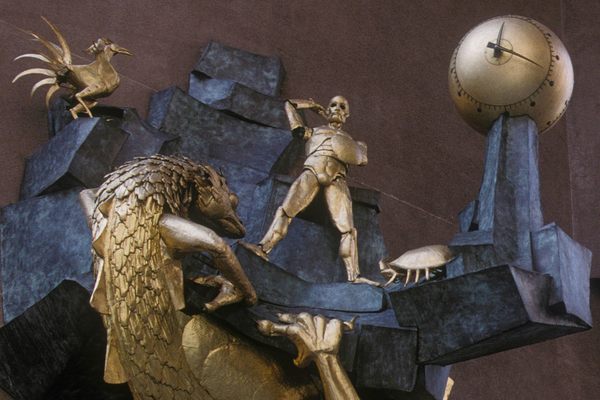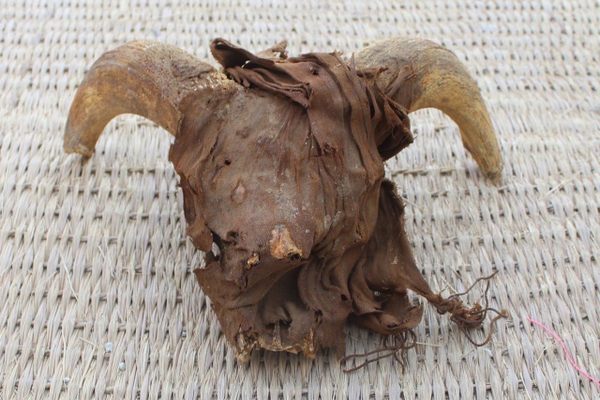Wonder Is Everywhere: Civil War Gold, a New Moai, and More From Around the Web
Get a peek into what we’re obsessed with right now.
Every other week, Atlas Obscura drags you down some of the rabbit holes we encounter as we search for our unusual stories. We highlight surprising finds, great writing, and inspiring stories from some of our favorite publications.

The Mystery of Salvador Dalí’s “Visions”
by Jacqui Palumbo, CNN.com
As curators at the Art Institute of Chicago prepared for an exhibit on Salvador Dalí, they began to worry that one of the paintings in the museum’s collection had been incorrectly attributed to the celebrated Surrealist. Their search for the truth led to the discovery of a hidden portrait and a forgotten mural.
The Turkish and Syrian Heritage Lost in the Recent Earthquakes
by Arie Amaya-Akkermans, The Art Newspaper
In the aftermath of two of the largest earthquakes ever to hit the Eastern Mediterranean, as Turkey and Syria struggle to house survivors, recover those still missing, and mourn the dead, the full scope of the the damage to the region’s heritage sites is also becoming clear. Among the hardest hit sites: Gaziantep Castle, built in the second millennium B.C.
Inside the FBI’s Secretive Search for Civil War–Era Gold in Pennsylvania
by Michael Rubinkam, Associated Press
In March 2018, the FBI went digging for Union gold believed to have been lost or stolen on its way to the U.S. Mint in Philadelphia in 1863. A federal judge has now ordered the public release of records pertaining to the treasure hunt. The secret is that it isn’t over—the FBI says it never found the booty.

Did a Giant Ancient Fish Unearthed in South Africa Prey on Human Ancestors?
by Sascha Pare, LiveScience
Researchers have identified a new species of giant tristichopterid: Hyneria udlezinye, a name derived from “one who consumes” in IsiXhosa, an Indigenous language in South Africa. The voracious predator fish, which lived about 350 million years ago, measured up to nine feet long, and had both fangs and an appetite for tetrapods. “The tristichopterids evolved into monsters that, in all likelihood, ate [our ancestors],” one scientist said.
Two Antlers in a Vietnamese Museum Are Actually Ancient Musical Instruments
Artnet
When they were found in the 1990s, these two 2,000-year-old antlers were consider simply well-preserved specimens from a long-dead Sambar deer or an Indian hog deer. Now researchers have determined they are also the earliest-known stringed instruments from the region. They were perhaps played like a k’ný, a modern single-string Vietnamese instrument known as a “mouth violin.”
This 500-Year-Old Nordic Shipwreck Still Has a Fully-Stocked Pantry
by Sarah Kuta, Smithsonian Magazine
When Gribshunden sank in the Baltic Sea off the coast of Sweden in 1495, it was carrying coveted foods and spices, meant as a diplomatic offering from King Hans of Denmark and Norway to the people of Sweden, whom he hoped would make him king of that country as well. Archaeologists have found evidence of 40 different types of fruits, vegetables, spices, nuts, and cereals in the wreck—including 13 ounces of saffron, which has, remarkably, retained its distinctive aroma for 527 years.

A New Moai Statue Was Discovered on Rapa Nui
by Angeline Jane Bernabe, Erin Brady, Faryn Shiro, and Robyn Weil, Good Morning America
Nearly 1,000 moai—human figures carved by the Rapa Nui people centuries ago—have been found on the Polynesian island that shares the name of the people (also known as Easter Island). The newest find, the smallest known, was discovered in a now-dry lake bed on the island, which is dealing with the effects of climate change.
The Two Brothers Who Made Helped Preserve Scores of Black Landmarks
by Nick Tabor, Washington Post
The Washington, D.C., home of Charlotte Forten Grimké—educator, abolitionist, activist, and poet—is just one of 67 Black history sites that became National Historic Landmarks in the 1970s thanks to the research and advocacy of Vincent deForest and his late brother Robert DeForrest, who founded the Afro-American Bicentennial Corp.

























































Follow us on Twitter to get the latest on the world's hidden wonders.
Like us on Facebook to get the latest on the world's hidden wonders.
Follow us on Twitter Like us on Facebook